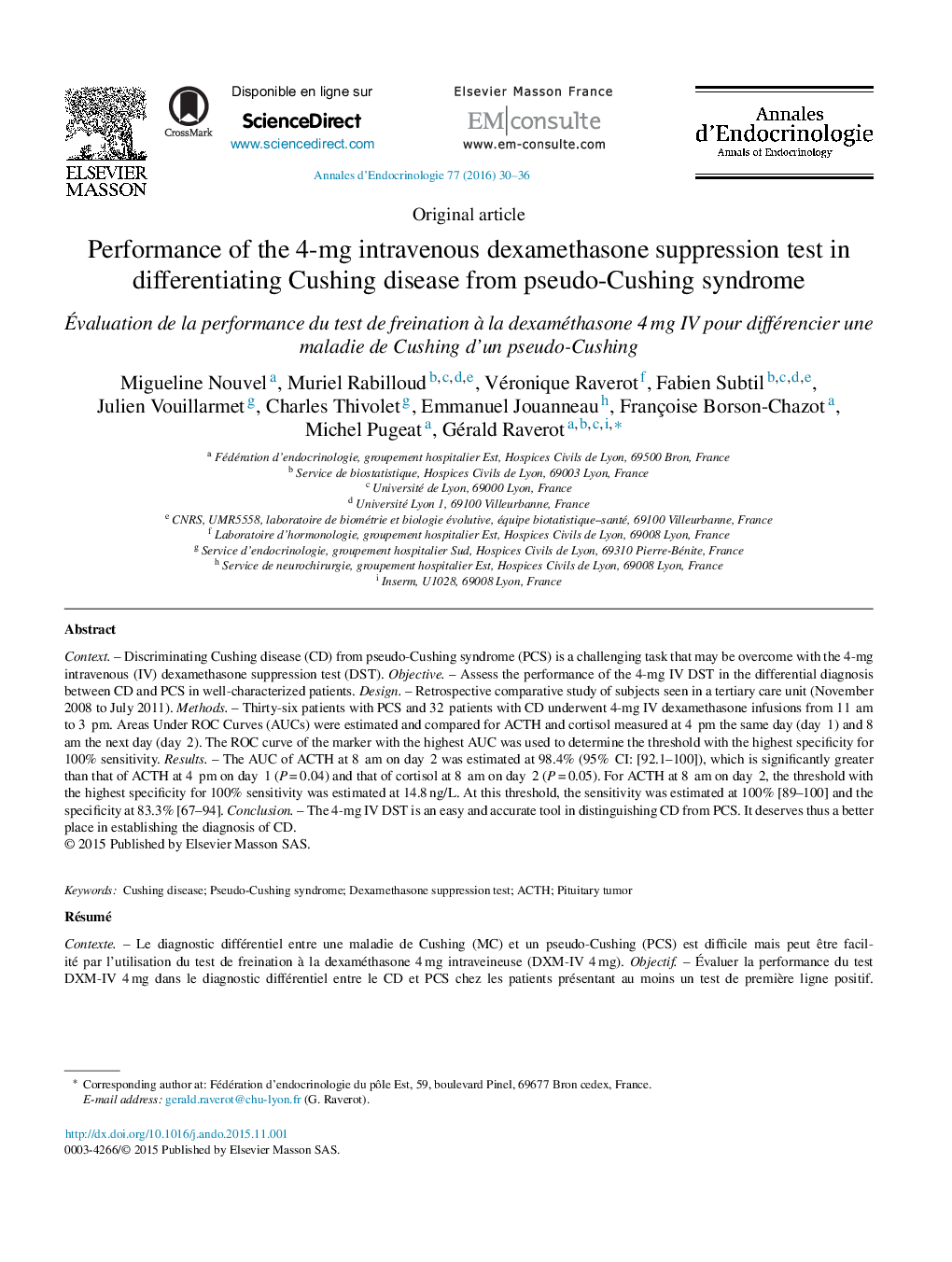| کد مقاله | کد نشریه | سال انتشار | مقاله انگلیسی | نسخه تمام متن |
|---|---|---|---|---|
| 3252299 | 1207056 | 2016 | 7 صفحه PDF | دانلود رایگان |
ContextDiscriminating Cushing disease (CD) from pseudo-Cushing syndrome (PCS) is a challenging task that may be overcome with the 4-mg intravenous (IV) dexamethasone suppression test (DST).ObjectiveAssess the performance of the 4-mg IV DST in the differential diagnosis between CD and PCS in well-characterized patients.DesignRetrospective comparative study of subjects seen in a tertiary care unit (November 2008 to July 2011).MethodsThirty-six patients with PCS and 32 patients with CD underwent 4-mg IV dexamethasone infusions from 11 am to 3 pm. Areas Under ROC Curves (AUCs) were estimated and compared for ACTH and cortisol measured at 4 pm the same day (day 1) and 8 am the next day (day 2). The ROC curve of the marker with the highest AUC was used to determine the threshold with the highest specificity for 100% sensitivity.ResultsThe AUC of ACTH at 8 am on day 2 was estimated at 98.4% (95% CI: [92.1–100]), which is significantly greater than that of ACTH at 4 pm on day 1 (P = 0.04) and that of cortisol at 8 am on day 2 (P = 0.05). For ACTH at 8 am on day 2, the threshold with the highest specificity for 100% sensitivity was estimated at 14.8 ng/L. At this threshold, the sensitivity was estimated at 100% [89–100] and the specificity at 83.3% [67–94].ConclusionThe 4-mg IV DST is an easy and accurate tool in distinguishing CD from PCS. It deserves thus a better place in establishing the diagnosis of CD.
RésuméContexteLe diagnostic différentiel entre une maladie de Cushing (MC) et un pseudo-Cushing (PCS) est difficile mais peut être facilité par l’utilisation du test de freination à la dexaméthasone 4 mg intraveineuse (DXM-IV 4 mg).ObjectifÉvaluer la performance du test DXM-IV 4 mg dans le diagnostic différentiel entre le CD et PCS chez les patients présentant au moins un test de première ligne positif.DesignÉtude comparative rétrospective des sujets vus dans une unité de soins tertiaires (novembre 2008 à juillet 2011).MéthodesTrente-six patients avec PCS et 32 patients avec MC ont été perfusé de 11–15 heures avec 4 mg de dexaméthasone. Les aires sous la courbes ROC (AUC) de l’ACTH et de cortisol mesurées à 16 heures le même jour (j1) et 8 heures le lendemain (j2) ont été analysées.RésultatsL’AUC de l’ACTH à 8 h à j2 a été estimée à 98,4 % (IC 95 % : [92,1–100]), ce qui est nettement supérieure à celle de l’ACTH à 16 h à j1 (p = 0,04) et du cortisol à 8 h à j2 (p = 0,05). Pour l’ACTH à 8 h à j2, le seuil avec la plus grande spécificité pour 100 % de sensibilité a été estimé à 14,8 ng/L. À ce seuil, la sensibilité est de 100 % [89–100] et la spécificité à 83,3 % [67–94].ConclusionLe test de freination par DXM-IV 4 mg est de réalisation simple et performant pour distinguer une MC d’un PCS. Ce test mérite d’être utilisé pour le diagnostic de CD.
Journal: Annales d'Endocrinologie - Volume 77, Issue 1, February 2016, Pages 30–36
